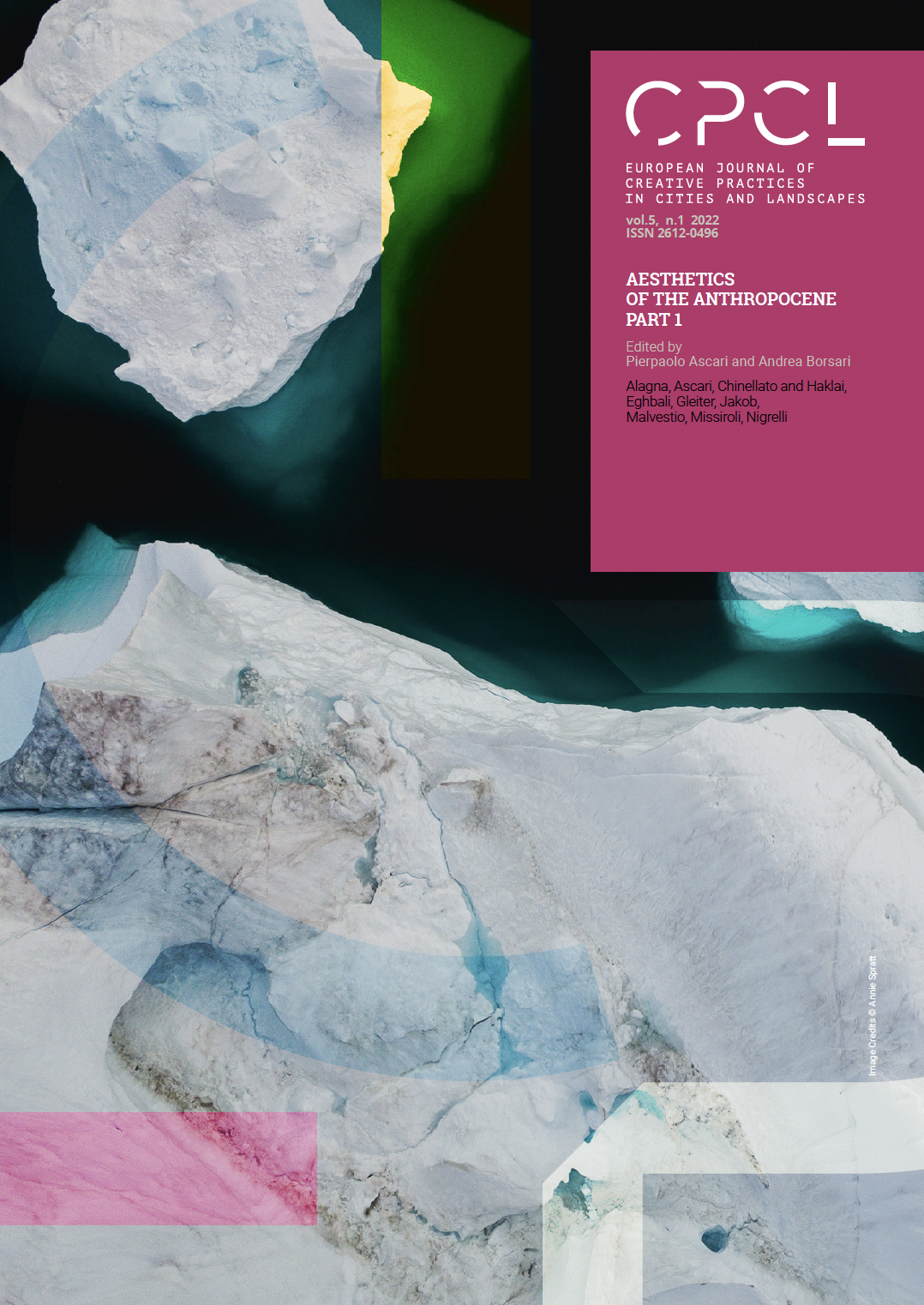Double Feature: Counter-Practices of World City Monumentality in the Age of the Anthropocene
DOI:
https://doi.org/10.6092/issn.2612-0496/14652Keywords:
world city, monumentality, counter-practice, Anthropocene, Tel AvivAbstract
This article examines the representational strategies of the world city in the age of the Anthropocene by concentrating the discussion on the notion of monumentality. By introducing the concept of ‘world city monumentality’, which can be defined as the projected anticipatory representation of the city’s desired global future embodied in the skyscraper, we attempt at illuminating on how monumentality is contested by its counter-practices, as significant artistic forms of experiential engagement in public space. To do so, we trace a critique of a specific world city monument, the Azrieli Center in Tel Aviv, Israel, by presenting our site-specific fictive intervention titled “Double Feature” (2021) as a case study.
References
Atti Architects, Eli. Shalom Center Competition. January 28, 1992.
Charney, Igal, and Gillad Rosen. "Splintering skylines in a fractured city: High-rise geographies in Jerusalem." Environment and Planning D: Society and Space 32, no. 6 (2014): 1088-1101. https://doi.org/10.1068%2Fd13174p
Crutzen, Paul. "Geography of Mankind." Nature 415 (2002): 23. https://doi.org/10.1038/415023a
Elliott, Cecil D. “Monuments and Monumentality.” Journal of Architectural Education (1947-1974) 18, no. 4 (1964): 51–53. https://doi.org/10.2307/1424164.
Ford, Larry R. "World cities and global change: observations on monumentality in urban design." Eurasian Geography and Economics 49, no. 3 (2008): 237-262. http://dx.doi.org/10.2747/1539-7216.49.3.237
Geddes, Patrick. Cities in evolution: An introduction to the town planning movement and to the study of civics. London: Williams & Norgate, 1915.
Graham, Stephen. Vertical: The city from satellites to bunkers. London: Verso Books, 2016.
Hall, Peter. The world cities. New York: McGraw-Hill, 1966.
Hay, Iain, Andrew Hughes, and Mark Tutton. "Monuments, memory and marginalisation in Adelaide's Prince Henry Gardens." Geografiska Annaler: Series B, Human Geography 86, no. 3 (2004): 201-216. https://doi.org/10.1111/j.0435-3684.2004.00162.x
Haraway, Donna. "Otherworldly conversations, terran topics, local terms." Material feminisms 3 (2008): 157. https://doi.org/10.1080/09505439209526336
Hénaff, Marcel. "Toward the Global city: Monument, Machine, and Network." Journal of the Institute for the Humanities 4 (2009): 22-30.
Huyssen, Andreas. Present pasts: Urban palimpsests and the politics of memory. Stanford: University Press, 2003.
Lahat, Shlomo. TEL AVIV HASHALOM CENTER – Israel’s Largest Commercial and Office Complex, 001/27/2446 (1991).
Massey, Doreen. "Places and their pasts." History workshop journal, no. 39 (1995): 182-192. https://doi.org/10.1093/HWJ%2F39.1.182
McNeill, Donald. "Skyscraper geography." Progress in human geography 29, no. 1 (2005): 41-55. https://doi.org/10.1191%2F0309132505ph527oa
Moore, Jason W., ed. Anthropocene Or Capitalocene? Nature, History, and the Crisis of Capitalism. United States: PM Press, 2016.
Moore, Jason W. “The Capitalocene, Part I: on the nature and origins of our ecological crisis.” The Journal of Peasant Studies 44, no. 3 (2017): 594-630. https://doi.org/10.1080/03066150.2016.1235036
Ong, Aihwa. “Hyperbuilding: Spectacle, Speculation, and the Hyperspace of Sovereignty.” Worlding Cities: Asian Experiments and the Art of being Global. UC Berkeley. (2011): 205-226. http://dx.doi.org/10.1002/9781444346800.ch8
Bellentani, Federico, and Mario Panico. "The meanings of monuments and memorials: toward a semiotic approach." Punctum. International journal of semiotics 2, no. 1 (2016): 28-46. http://dx.doi.org/10.18680/hss.2016.0004
Sassen, Saskia. The Global City: New York, London, Tokyo. United Kingdom: Princeton University Press, 2013.
Staal, Jonas. “Monument to Capital.” Accessed March 10, 2022. https://www.uncubemagazine.com/blog/15508779?wt_mc=nluw.2015-04-17.content.linkartikel.
Vickery, Jonathan. "The past and possible future of counter monument." IXIA: the public art think tank 351 (2012).
Widrich, Mechtild. Performative Monuments: The rematerialisation of public art. Manchester: University Press, 2014.
Young, James E. "The counter-monument: memory against itself in Germany today." Critical inquiry 18, no. 2 (1992): 267-296. https://doi.org/10.1086/448632
Downloads
Published
How to Cite
Issue
Section
License
Copyright (c) 2022 Enrico Chinellato, Or Haklai

This work is licensed under a Creative Commons Attribution 4.0 International License.




